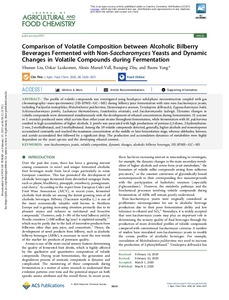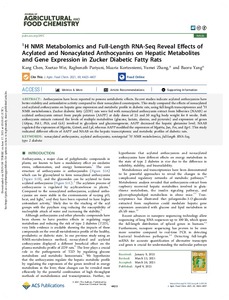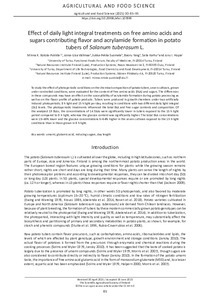Hae
Aineistot 31-40 / 66
Effect of Saccharomyces cerevisiae and Schizosaccharomyces pombe strains on chemical composition and sensory quality of ciders made from Finnish apple cultivars
Composition of volatile compounds and concentrations of sugars and organic acids were studied in apple ciders produced with <i>Saccharomyces cerevisiae</i> and <i>Schizosaccharomyces pombe</i> yeasts using eleven different ...
Tissue-Specific Content of Polyunsaturated Fatty Acids in (n-3) Deficiency State of Rats
The dietary intake of fatty acids (FAs) affects the composition and distribution of FAs in the body. Here, a first-generation (n-3)-deficiency study was conducted by keeping young (age 21 & PLUSMN; 2 days) Sprague-Dawley ...
Bioavailability of docosahexaenoic acid 22:6(n-3) from enantiopure triacylglycerols and their regioisomeric counterpart in rats
Lack of synthetic enantiospecific triacylglycerols (TAGs) has hindered our understanding of the impact of TAG structure on the absorption and metabolic fate of fatty acids (FAs). In a five-day feeding trial with mildly ...
Comparison of Volatile Composition between Alcoholic Bilberry Beverages Fermented with Non- Saccharomyces Yeasts and Dynamic Changes in Volatile Compounds during Fermentation
<p>The profile of volatile compounds was investigated using headspace solid-phase microextraction coupled with gas chromatography–mass spectrometry (HS-SPME–GC–MS) during bilberry juice fermentation with nine non-Saccharomyces ...
Direct inlet negative ion chemical ionization tandem mass spectrometric analysis of triacylglycerol regioisomers in human milk and infant formulas
A previously developed direct inlet tandem mass spectrometric method for analysis of triacylglycerol (TAG) regioisomers was updated and validated for operation with current instrumentation with improved sensitivity and ...
H-1 NMR Metabolomics and Full-Length RNA-Seq Reveal Effects of Acylated and Nonacylated Anthocyanins on Hepatic Metabolites and Gene Expression in Zucker Diabetic Fatty Rats
Anthocyanins have been reported to possess antidiabetic effects. Recent studies indicate acylated anthocyanins have better stability and antioxidative activity compared to their nonacylated counterparts. This study compared ...
Berry polyphenols and human health: evidence of antioxidant, anti-inflammatory, microbiota modulation, and cell-protecting effects
<p>Abstract<br></p><p>Studies have revealed more positive effects of berries’ components over the years, representing a growing trend in their consumption. Phenolic compounds, such as anthocyanins, flavonols, and phenolic ...
Effect of daily light integral treatments on free amino acids and sugars contributing flavor and acrylamide formation in potato tubers of Solanum tuberosum L.
To study the effect of photoperiodic conditions on the chemical composition of potato tubers, seven cultivars, grown under controlled conditions, were evaluated for the content of free amino acids (FAA) and sugars. The ...
Health promoting properties and sensory characteristics of phytochemicals in berries and leaves of sea buckthorn (Hippophaë rhamnoides)
<p>Sea buckthorn (<i>Hippophaë rhamnoides</i> L., SB), as a
multi-functional plant, is widely grown in Asia, Europe and Canada. The
berries and leaves of SB contain a diverse array of health-supporting
phytochemicals, ...
Antimicrobial activity of cyanidin-3-O-glucoside–lauric acid ester against Staphylococcus aureus and Escherichia coli
<p> Enzymatic acylation of anthocyanin with fatty acid improves its lipophilic solubility and application potential. Nevertheless, evaluation of functional properties of product is premise for application. This study investigated the antimicrobial potential and the underlying mechanisms of an acylated anthocyanin, namely, cyanidin-3-O-glucoside–lauric acid ester (C3G-LA), to provide guidelines for its application. C3G-LA exhibited outstanding antibacterial activity against Staphylococcus aureus [minimum inhibitory concentration (MIC) = 0.3125 mg/mL] and modest activity against Escherichia coli (MIC = 5 mg/mL). Moreover, C3G-LA manifested bactericide ability against S. aureus at 0.625 mg/mL. Decreases in membrane integrity (by 96% and 92% at MIC in S. aureus and E. coli, respectively), intracellular ATP concentration (by 96% and 92%) and intracellular pH (by 11% and 9%) and changes in cellular morphology altogether indicated the dysfunction of cell membrane under C3G-LA treatment. These findings demonstrated that C3G-LA could be adopted as an alternative food preservative against foodborne pathogens. <br></p>...








